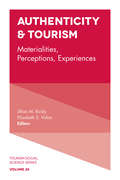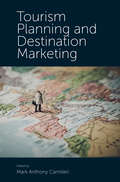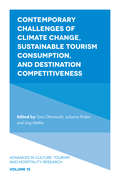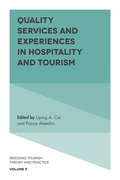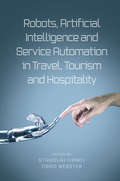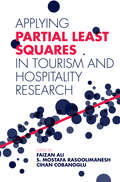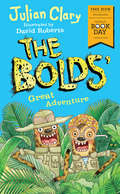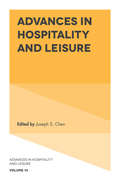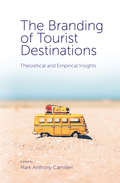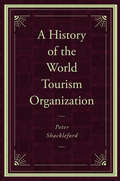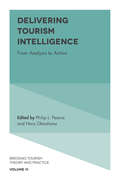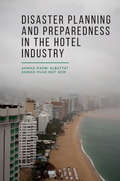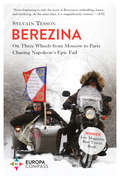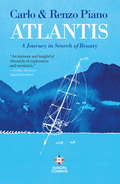- Table View
- List View
Authenticity & Tourism: Materialities, Perceptions, Experiences (Tourism Social Science Series #24)
by Jillian M. Rickly Elizabeth S. VidonDebates around the concept of authenticity date to the earliest theories of tourism, as scholars attempted to understand motivations for traveling away from 'home' and touristic experiences of places far 'away'. Over time, theories of authenticity have burgeoned from epistemological to ontological notions drawing a broad range of philosophers into tourism research. This edited volume features chapters that engage with key debates about authenticity – its materiality, how it is perceived, and how it is experienced. The book is comprised of four sections thematically organized around popular trends in authenticity research in tourism, making this volume appropriate as both a comprehensive text and as individual investigations. Authenticity & Tourism: Materialities, Perceptions, Experiences includes chapters that engage with the pragmatic and the theoretical, including conversations on marketing and the production of tourism attractions, examinations of the constructive nature of authenticity, and the politics of authentication processes. Also included are contributions that revisit technological trends in tourism and advance debates of authenticity in souvenirs, photographs, and simulated experiences, as well as those more firmly anchored in the theoretical, pushing boundaries and establishing paths for future research. Across these chapters, the authors employ a range of methodologies, from autoethnography to photo and food-elicitation combinations to discourse and content analyses. Set against a backdrop of truly global case studies, this collection exemplifies the multiple facets of authenticity research in tourism.
Authenticity & Tourism: Materialities, Perceptions, Experiences (Tourism Social Science Series #24)
by Jillian M. Rickly Elizabeth S. VidonDebates around the concept of authenticity date to the earliest theories of tourism, as scholars attempted to understand motivations for traveling away from 'home' and touristic experiences of places far 'away'. Over time, theories of authenticity have burgeoned from epistemological to ontological notions drawing a broad range of philosophers into tourism research. This edited volume features chapters that engage with key debates about authenticity – its materiality, how it is perceived, and how it is experienced. The book is comprised of four sections thematically organized around popular trends in authenticity research in tourism, making this volume appropriate as both a comprehensive text and as individual investigations. Authenticity & Tourism: Materialities, Perceptions, Experiences includes chapters that engage with the pragmatic and the theoretical, including conversations on marketing and the production of tourism attractions, examinations of the constructive nature of authenticity, and the politics of authentication processes. Also included are contributions that revisit technological trends in tourism and advance debates of authenticity in souvenirs, photographs, and simulated experiences, as well as those more firmly anchored in the theoretical, pushing boundaries and establishing paths for future research. Across these chapters, the authors employ a range of methodologies, from autoethnography to photo and food-elicitation combinations to discourse and content analyses. Set against a backdrop of truly global case studies, this collection exemplifies the multiple facets of authenticity research in tourism.
Tourism Planning and Destination Marketing
by Mark Anthony CamilleriDestination marketing relies on planning, organisation, and successful strategies and tactics. Tourism Planning and Destination Marketing provides an in-depth understanding of the tourism marketing environment, including destination branding, distribution channels, etourism, digital media, and sustainable and responsible tourism practices. It is a useful guide for tourism marketers, including destination management organisations (DMOs), who are increasingly using innovative tools and evolving technologies to engage with prospective visitors. Moreover, this title sheds light on the latest developments in travel, hospitality, festivals and events, as the contributing authors have critically analysed the global tourism marketing environments that comprise a wide array of economic, socio-cultural, technological and environmental realities. This book explores advances in tourism planning and destination marketing theory for the interest of both researchers and scholars. Furthermore, it is an invaluable resource for a wide range of industry practitioners, including consultants, senior executives and managers who work for destination management organisations, tourism offices, hotels, inbound/outbound tour operators and travel agents.
Tourism Planning and Destination Marketing
by Mark Anthony CamilleriDestination marketing relies on planning, organisation, and successful strategies and tactics. Tourism Planning and Destination Marketing provides an in-depth understanding of the tourism marketing environment, including destination branding, distribution channels, etourism, digital media, and sustainable and responsible tourism practices. It is a useful guide for tourism marketers, including destination management organisations (DMOs), who are increasingly using innovative tools and evolving technologies to engage with prospective visitors. Moreover, this title sheds light on the latest developments in travel, hospitality, festivals and events, as the contributing authors have critically analysed the global tourism marketing environments that comprise a wide array of economic, socio-cultural, technological and environmental realities. This book explores advances in tourism planning and destination marketing theory for the interest of both researchers and scholars. Furthermore, it is an invaluable resource for a wide range of industry practitioners, including consultants, senior executives and managers who work for destination management organisations, tourism offices, hotels, inbound/outbound tour operators and travel agents.
Contemporary Challenges of Climate Change, Sustainable Tourism Consumption, and Destination Competitiveness (Advances in Culture, Tourism and Hospitality Research #15)
by Timo Ohnmacht Julianna Priskin Jürg StettlerThis volume presents twenty updated and new theories of travelers’ decisions and behaviors. It describes the advances in theory construction and practical applications of theory in the disciplines of tourism, hospitality, leisure, and entertainment (THLE) research. The chapters all build on the grand models appearing in these four literature streams during 1965-2015. This approach is comprehensive in both coverage and depth with regard to constructing, testing, and applying theories of travelers’ decisions and behaviors, which includes original work in updating grand theories and micro (algorithm-conscious and non-conscious based) theories of travelers’ decisions and behavior. This volume is the first to fully recognize and construct theories across the THLE discipline. This volume describes the synergies, symbioses, and serendipity occurring in THLE behavior. It tears down researchers' parochial fences of what is and is not tourism, hospitality, leisure, and entertainment. The time has arrived tor tourism to embrace hospitality, hospitality to embrace tourism, and all to embrace leisure and entertainment, and this volume serves as a catalyst to accomplish this embrace.
Contemporary Challenges of Climate Change, Sustainable Tourism Consumption, and Destination Competitiveness (Advances in Culture, Tourism and Hospitality Research #15)
by Timo Ohnmacht Julianna Priskin Jürg StettlerThis volume presents twenty updated and new theories of travelers’ decisions and behaviors. It describes the advances in theory construction and practical applications of theory in the disciplines of tourism, hospitality, leisure, and entertainment (THLE) research. The chapters all build on the grand models appearing in these four literature streams during 1965-2015. This approach is comprehensive in both coverage and depth with regard to constructing, testing, and applying theories of travelers’ decisions and behaviors, which includes original work in updating grand theories and micro (algorithm-conscious and non-conscious based) theories of travelers’ decisions and behavior. This volume is the first to fully recognize and construct theories across the THLE discipline. This volume describes the synergies, symbioses, and serendipity occurring in THLE behavior. It tears down researchers' parochial fences of what is and is not tourism, hospitality, leisure, and entertainment. The time has arrived tor tourism to embrace hospitality, hospitality to embrace tourism, and all to embrace leisure and entertainment, and this volume serves as a catalyst to accomplish this embrace.
Quality Services and Experiences in Hospitality and Tourism (Bridging Tourism Theory and Practice #9)
by Liping A. Cai Pooya AlaediniThis volume presents the latest perspectives and practices on quality services and experiences in hospitality and tourism. It offers conceptual discourse, empirical evidence, application of existing and emerging theories, and considers the implications of practical findings to extend beyond the academic realm of service quality, and examine the quality issues of both services provided and experiences encountered across a wide spectrum of tourism sectors. As such, it provides new intelligence and contributes to the study of new consumers, as well as organizations and destinations that serve and host them. The book continues the series’ tradition of connecting scholarly works and real-world cases, with a unique mix of geographic representations. The majority of its chapters are drawn from the proceedings of the 2016 conference on Service Quality in Hospitality and Tourism: Experiencing Persian Heritage held in Isfahan, Iran. The regional focus of the conference is augmented in this book with contributions from elsewhere, resulting in a more diverse and global context for the treatment of quality services and experiences in hospitality and tourism. The volume will appeal to academic scholars and industry professionals interested in exploring new frontiers of knowledge on the subject. Organized in three parts with distinctive themes, the chapters are appropriate course readings, either collectively or selectively, for undergraduate and graduate students in educational programs focusing on global curricula.
Robots, Artificial Intelligence and Service Automation in Travel, Tourism and Hospitality
by Stanislav Ivanov Craig WebsterUsing a combination of theoretical discussion and real-world case studies, this book analyses the use of robotics, artificial intelligence and services automation (RAISA) within the travel, tourism and hospitality industries. Divided into two sections, the book first concentrates on the theoretical aspects surrounding the use of RAISA in travel, tourism and hospitality. Themes explored include: economic fundamentals customer attitudes chatbot adoption service quality Following on from this, the second section concentrates on current and future use of RAISA technologies in specific subsectors of the tourism economy: hotels, restaurants, travel agencies, museums, and events. With an international scope of authorship and focus, the book is a useful reference source for scholars, students, and general readers interested in robotics, artificial intelligence, and automation technologies. Alongside this, the business insights and case studies examined in the book offer practitioners guidance on how these technologies can and will be incorporated into organizations, particularly those in the travel and tourism industry.
Robots, Artificial Intelligence and Service Automation in Travel, Tourism and Hospitality
by Stanislav Ivanov Craig WebsterUsing a combination of theoretical discussion and real-world case studies, this book analyses the use of robotics, artificial intelligence and services automation (RAISA) within the travel, tourism and hospitality industries. Divided into two sections, the book first concentrates on the theoretical aspects surrounding the use of RAISA in travel, tourism and hospitality. Themes explored include: economic fundamentals customer attitudes chatbot adoption service quality Following on from this, the second section concentrates on current and future use of RAISA technologies in specific subsectors of the tourism economy: hotels, restaurants, travel agencies, museums, and events. With an international scope of authorship and focus, the book is a useful reference source for scholars, students, and general readers interested in robotics, artificial intelligence, and automation technologies. Alongside this, the business insights and case studies examined in the book offer practitioners guidance on how these technologies can and will be incorporated into organizations, particularly those in the travel and tourism industry.
Applying Partial Least Squares in Tourism and Hospitality Research
by Faizan Ali S. Mostafa Rasoolimanesh Cihan CobanogluPartial-least-squares path modeling (PLS-PM), a composite-based form of structural equation modeling (SEM), offers great practical advantages to researchers and practitioners. It has been gaining increasing attention in various disciplines, including management information systems, marketing, strategic management, accounting, family business research, operations management, and organizational research. Yet advanced PLS-SEM techniques are not broadly used in hospitality and tourism research, which spells missed opportunities in terms of detailed analyses and actionable findings. Applying Partial Least Squares in Tourism and Hospitality Research provides a forum for leading names in the field to discuss the major topical issues and to demonstrate the usefulness of PLS path modeling for academics and practitioners in hospitality and tourism. Its ten chapters discuss key aspects of advanced PLS analysis and its practical applications, covering new guidelines and improvements in the use of PLS-PM as well as individual topics such as multi-group analysis (PLS-MGA), the predictive qualities of PLS models, minimum sample size estimation methods, the reporting of mediation and moderation analysis, the assessment of the reliability of reflectively measured constructs, and the assessment of overall model fit through consistent PLS and the bootstrap-based test. This comprehensive coverage serves both as an introduction to PLS for the uninitiated and as a go-to reference work for researchers and practitioners interested in the most recent advances in PLS methodology. Applying Partial Least Squares in Tourism and Hospitality Research is a must-read for academics in hospitality and tourism research and for hospitality and tourism practitioners such as industry consultants. Insofar as it can serve as a guidebook to recent advances within PLS-SEM, it is also of interest to researchers from other disciplines including management, business, and marketing.
Applying Partial Least Squares in Tourism and Hospitality Research
by Faizan Ali S. Mostafa Rasoolimanesh Cihan CobanogluPartial-least-squares path modeling (PLS-PM), a composite-based form of structural equation modeling (SEM), offers great practical advantages to researchers and practitioners. It has been gaining increasing attention in various disciplines, including management information systems, marketing, strategic management, accounting, family business research, operations management, and organizational research. Yet advanced PLS-SEM techniques are not broadly used in hospitality and tourism research, which spells missed opportunities in terms of detailed analyses and actionable findings. Applying Partial Least Squares in Tourism and Hospitality Research provides a forum for leading names in the field to discuss the major topical issues and to demonstrate the usefulness of PLS path modeling for academics and practitioners in hospitality and tourism. Its ten chapters discuss key aspects of advanced PLS analysis and its practical applications, covering new guidelines and improvements in the use of PLS-PM as well as individual topics such as multi-group analysis (PLS-MGA), the predictive qualities of PLS models, minimum sample size estimation methods, the reporting of mediation and moderation analysis, the assessment of the reliability of reflectively measured constructs, and the assessment of overall model fit through consistent PLS and the bootstrap-based test. This comprehensive coverage serves both as an introduction to PLS for the uninitiated and as a go-to reference work for researchers and practitioners interested in the most recent advances in PLS methodology. Applying Partial Least Squares in Tourism and Hospitality Research is a must-read for academics in hospitality and tourism research and for hospitality and tourism practitioners such as industry consultants. Insofar as it can serve as a guidebook to recent advances within PLS-SEM, it is also of interest to researchers from other disciplines including management, business, and marketing.
Quality Services and Experiences in Hospitality and Tourism (Bridging Tourism Theory and Practice #9)
by Liping A. Cai Pooya AlaediniThis volume presents the latest perspectives and practices on quality services and experiences in hospitality and tourism. It offers conceptual discourse, empirical evidence, application of existing and emerging theories, and considers the implications of practical findings to extend beyond the academic realm of service quality, and examine the quality issues of both services provided and experiences encountered across a wide spectrum of tourism sectors. As such, it provides new intelligence and contributes to the study of new consumers, as well as organizations and destinations that serve and host them. The book continues the series’ tradition of connecting scholarly works and real-world cases, with a unique mix of geographic representations. The majority of its chapters are drawn from the proceedings of the 2016 conference on Service Quality in Hospitality and Tourism: Experiencing Persian Heritage held in Isfahan, Iran. The regional focus of the conference is augmented in this book with contributions from elsewhere, resulting in a more diverse and global context for the treatment of quality services and experiences in hospitality and tourism. The volume will appeal to academic scholars and industry professionals interested in exploring new frontiers of knowledge on the subject. Organized in three parts with distinctive themes, the chapters are appropriate course readings, either collectively or selectively, for undergraduate and graduate students in educational programs focusing on global curricula.
The Bolds' Great Adventure: World Book Day 2018 (The Bolds)
by Julian Clary David RobertsFasten your seatbelts - it's a special adventure for World Book Day with Teddington's wildest family! Learn just how our intrepid hyenas managed to get from their African safari park onto the plane and off to their new home in England. It's quite a remarkable, and some would say, unbelievable tale - but there are many laughs along the way!
Advances in Hospitality and Leisure (Advances in Hospitality and Leisure #14)
by Joseph S. ChenAdvances in Hospitality and Leisure (AHL), a peer-reviewed research journal, has been published annually since 2004. AHL is indexed in Scopus and included in the Australian Business Deans Council (ABDC) journal quality list. Its editors, editorial board members and ad-hoc reviewers include scholars from North America, Europe and Asia-Pacific. AHL utilizes this international focus to participate in innovative methods of inquiry and inspire new research topics that are vital and have been in large neglected in the context of hospitality, tourism, and leisure. It strives to address the needs of the populace willing to disseminate seminal ideas, concepts, and theories derived from scholarly inquiries. This volume includes full papers and research notes which discuss conceptual models and empirical investigations using inductive and deductive methods. Potential readers may retrieve useful articles to outline new research agendas, suggest viable topics for a dissertation work, and augment the knowledge of the new subjects of learning.
Advances in Hospitality and Leisure (Advances in Hospitality and Leisure #14)
by Joseph S. ChenAdvances in Hospitality and Leisure (AHL), a peer-reviewed research journal, has been published annually since 2004. AHL is indexed in Scopus and included in the Australian Business Deans Council (ABDC) journal quality list. Its editors, editorial board members and ad-hoc reviewers include scholars from North America, Europe and Asia-Pacific. AHL utilizes this international focus to participate in innovative methods of inquiry and inspire new research topics that are vital and have been in large neglected in the context of hospitality, tourism, and leisure. It strives to address the needs of the populace willing to disseminate seminal ideas, concepts, and theories derived from scholarly inquiries. This volume includes full papers and research notes which discuss conceptual models and empirical investigations using inductive and deductive methods. Potential readers may retrieve useful articles to outline new research agendas, suggest viable topics for a dissertation work, and augment the knowledge of the new subjects of learning.
The Branding of Tourist Destinations: Theoretical and Empirical Insights
by Mark Anthony CamilleriThe marketing of tourist destinations requires continuous strategic planning and decision making. The Branding of Tourist Destinations: Theoretical and Empirical Insights provides researchers and practitioners with an in-depth understanding of different tourism products, marketing strategies and destination branding tactics, as well as useful insights into sustainable and responsible tourism practices.The authors present contemporary conceptual discussions and empirical studies on several aspects of destination branding that help contextualise the attractiveness of a range of tourist destinations. In particular, they explore how tourism marketers, including destination management organisations (DMOs), formulate strategies and tactics to attract prospective visitors. This book also sheds light on the latest industry developments in travel, tourism, hospitality and events in different contexts around the world, including destinations in Sweden, Portugal, Spain, Italy and Ecuador.
The Branding of Tourist Destinations: Theoretical and Empirical Insights
by Mark Anthony CamilleriThe marketing of tourist destinations requires continuous strategic planning and decision making. The Branding of Tourist Destinations: Theoretical and Empirical Insights provides researchers and practitioners with an in-depth understanding of different tourism products, marketing strategies and destination branding tactics, as well as useful insights into sustainable and responsible tourism practices.The authors present contemporary conceptual discussions and empirical studies on several aspects of destination branding that help contextualise the attractiveness of a range of tourist destinations. In particular, they explore how tourism marketers, including destination management organisations (DMOs), formulate strategies and tactics to attract prospective visitors. This book also sheds light on the latest industry developments in travel, tourism, hospitality and events in different contexts around the world, including destinations in Sweden, Portugal, Spain, Italy and Ecuador.
A History of the World Tourism Organization
by Peter ShacklefordTourism and travel have been with us since time immemorial. However, with the onset of the industrial age and the use of railways, ships, motorcars, and aeroplanes, travelling possibilities—for both business and pleasure, domestic and international—were transformed. The annals of the United Nations World Tourism Organization (UNWTO) provide us with unmatched insights into this fascinating story, yet these archives have never been exhaustively exploited. The History of the World Tourism Organization takes us on a unique journey to explain how tourism has burgeoned between the early twentieth century and now. Drawing on the UNWTO’s regularly published tourism statistics, this book provides comprehensive discussions of the consequences of an unhindered flow of tourists; the consequent protection of natural assets; the safeguarding of tourism resources; how frontier formalities affect this sector; how tourism impacts on world trade; and the promotion of tourism to countries in economic decline. Collectively, these investigations offer an impartial understanding of modern tourism and its effects. This definitive overview of this major intergovernmental organization is a must-read for students and scholars of tourism and hospitality, and it is of interest to anyone concerned with the past, present, and future of this ever-evolving and fundamentally human practice.
A History of the World Tourism Organization
by Peter ShacklefordTourism and travel have been with us since time immemorial. However, with the onset of the industrial age and the use of railways, ships, motorcars, and aeroplanes, travelling possibilities—for both business and pleasure, domestic and international—were transformed. The annals of the United Nations World Tourism Organization (UNWTO) provide us with unmatched insights into this fascinating story, yet these archives have never been exhaustively exploited. The History of the World Tourism Organization takes us on a unique journey to explain how tourism has burgeoned between the early twentieth century and now. Drawing on the UNWTO’s regularly published tourism statistics, this book provides comprehensive discussions of the consequences of an unhindered flow of tourists; the consequent protection of natural assets; the safeguarding of tourism resources; how frontier formalities affect this sector; how tourism impacts on world trade; and the promotion of tourism to countries in economic decline. Collectively, these investigations offer an impartial understanding of modern tourism and its effects. This definitive overview of this major intergovernmental organization is a must-read for students and scholars of tourism and hospitality, and it is of interest to anyone concerned with the past, present, and future of this ever-evolving and fundamentally human practice.
Delivering Tourism Intelligence: From Analysis to Action (Bridging Tourism Theory and Practice #11)
by Philip L. Pearce Hera OktadianaTourism researchers are feeling mounting pressure to answer an increasing number of questions from external agents which challenge the ability of their findings to deliver tangible change. Delivering Tourism Intelligence demonstrates that good academic analysis can deliver quality implications for a range of stakeholders. Contributions from authors across the continents serve to illustrate ways in which academic analysis can, and does, result in action. The chapters in this volume are organised into three parts: governance, planning and sustainability; consumer benefits and experiences; and benefits to entrepreneurs. The chapter authors provide a rich array of examples and cases from Europe, Africa, Asia and Australia, all of which reveal that academic studies can play a strong role in fostering positive changes relevant to the needs of varied stakeholders. Key themes revolve around the need for stakeholder trust, the ability of researchers to use tools for insights, the value of identifying new trends and tourism topics, the importance of understanding target markets, the usefulness of universities and researchers for providing training, and an appreciation of the time it takes for some ideas to be implemented. With individual chapters which address hotel management, destination management, markets and community sustainability, as well as public policy topics, this book will appeal to postgraduates studying in these areas as well as those practitioners and policy makers working in applied sectors.
Delivering Tourism Intelligence: From Analysis to Action (Bridging Tourism Theory and Practice #11)
by Philip L. Pearce Hera OktadianaTourism researchers are feeling mounting pressure to answer an increasing number of questions from external agents which challenge the ability of their findings to deliver tangible change. Delivering Tourism Intelligence demonstrates that good academic analysis can deliver quality implications for a range of stakeholders. Contributions from authors across the continents serve to illustrate ways in which academic analysis can, and does, result in action. The chapters in this volume are organised into three parts: governance, planning and sustainability; consumer benefits and experiences; and benefits to entrepreneurs. The chapter authors provide a rich array of examples and cases from Europe, Africa, Asia and Australia, all of which reveal that academic studies can play a strong role in fostering positive changes relevant to the needs of varied stakeholders. Key themes revolve around the need for stakeholder trust, the ability of researchers to use tools for insights, the value of identifying new trends and tourism topics, the importance of understanding target markets, the usefulness of universities and researchers for providing training, and an appreciation of the time it takes for some ideas to be implemented. With individual chapters which address hotel management, destination management, markets and community sustainability, as well as public policy topics, this book will appeal to postgraduates studying in these areas as well as those practitioners and policy makers working in applied sectors.
Disaster Planning and Preparedness in the Hotel Industry
by Ahmad Rasmi Albattat Ahmad Puad Mat SomDisasters experienced by the hospitality industry have steadily increased over the past few decades, and the industry has emerged as one of the most vulnerable businesses to disasters and emergencies, with a wave of catastrophic events striking it in recent years. Disaster management has become a vital tool as key industry players seek ways to cope with these unexpected events. Disaster Planning and Preparedness in the Hotel Industry reveals that a majority of hotels are not financially capable to prepare and train personnel, and unable to afford financing activities or disaster and emergency preparedness plans and programs. Furthermore, it finds that although emergencies bring about trauma and hardship in hotels, they are at the same time establishing a re-engineered life cycle. The book goes on to suggest that for hotels to be well managed and adequately prepared for emergency, all stakeholders should be engaged in removing setbacks and barriers to effective disaster and emergency management and planning. It concludes that Jordanian hotel managers and stakeholders should establish a well detailed emergency planning and preparedness schedule and outline details of the collaborative management plan for emergency cases. By identifying major emergencies that have occurred in the hotel industry; investigating hotels’ preparation for emergencies in the past; and exploring how hotels manage and overcome such emergencies; this book will increase the awareness of emergency managers and scholars on how to read, manage, and overcome the impact of emergencies in the hospitality industry.
Disaster Planning and Preparedness in the Hotel Industry
by Ahmad Rasmi Albattat Ahmad Puad Mat SomDisasters experienced by the hospitality industry have steadily increased over the past few decades, and the industry has emerged as one of the most vulnerable businesses to disasters and emergencies, with a wave of catastrophic events striking it in recent years. Disaster management has become a vital tool as key industry players seek ways to cope with these unexpected events. Disaster Planning and Preparedness in the Hotel Industry reveals that a majority of hotels are not financially capable to prepare and train personnel, and unable to afford financing activities or disaster and emergency preparedness plans and programs. Furthermore, it finds that although emergencies bring about trauma and hardship in hotels, they are at the same time establishing a re-engineered life cycle. The book goes on to suggest that for hotels to be well managed and adequately prepared for emergency, all stakeholders should be engaged in removing setbacks and barriers to effective disaster and emergency management and planning. It concludes that Jordanian hotel managers and stakeholders should establish a well detailed emergency planning and preparedness schedule and outline details of the collaborative management plan for emergency cases. By identifying major emergencies that have occurred in the hotel industry; investigating hotels’ preparation for emergencies in the past; and exploring how hotels manage and overcome such emergencies; this book will increase the awareness of emergency managers and scholars on how to read, manage, and overcome the impact of emergencies in the hospitality industry.
Berezina
by Sylvain TessonOctober 1812, Napoleon enters Moscow. The Russians have set fire to the city, soon it will be reduced to a pile of ash. The Emperor equivocates, decides to turn back. This is the beginning of the retreat from Russia, a page of history that has become legendary for its degree of suffering and horror, but also for the heroic acts that took place.Two hundred years later, Sylvain Tesson, accompanied by four friends (two Russians and two French), decides to follow the route of the retreat. Perched on two Soviet Ural sidecar motorcycles, they will rejoin Paris from Moscow, guided only by the spectres of the two hundred thousand soldiers who died through cold, starvation, and in battle. Twenty five hundred miles travelled in a wild escapade to salute the ghosts of history, across the white plains of Russia.
Atlantis: A Journey in Search of Beauty
by Carlo Piano Renzo PianoWorld-famous architect Renzo Piano and his son Carlo set sail from Genoa one late Summer day, guided by the ancestral desire felt by many explorers before them: to find Atlantis (in Italian, Atlantide). Atlantis is the perfect city, built to harbour a perfect society. This is its true beauty, precious and elusive. Renzo Piano, a man who can not only measure land at a glance but also the sea’s infinite geometry, returns to the places where he has erected his works, mosaic pieces in the infinite, necessary quest for perfection. With his son he sails across the Pacific, along the banks of the Thames and the Seine, reaching as far as Athens, San Francisco’s Golden Gate Park and Osaka Bay. In search of beauty, he finds the imperfections that every building project carries within it. And so, all that remains is to sail on.
